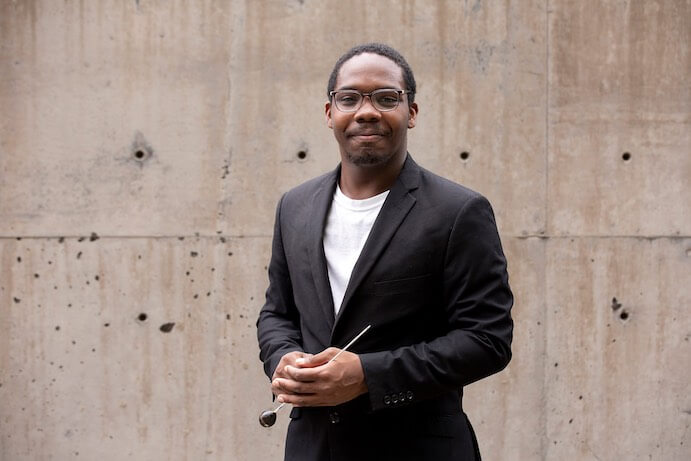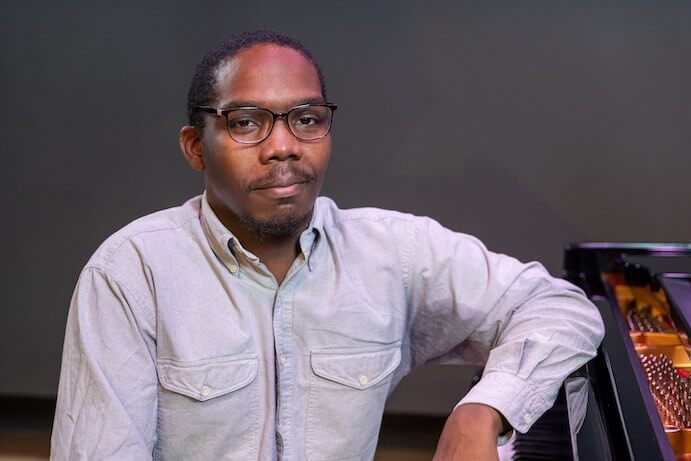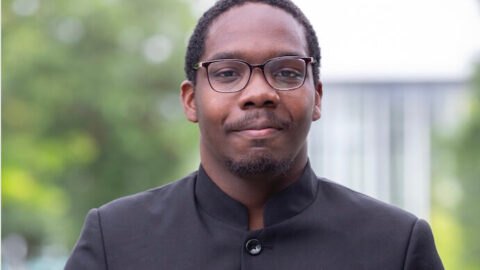This article was commissioned by American Composers Forum.
“I like to joke that some people grew up in the church, but I grew up in the concert hall…” quips ACF NextNotes alum Quinn Mason in our recent Zoom interview. “In a sense, the concert hall was kind of my church. I know that’s a bit of a controversial statement to some people, but that’s where I learned all that I know today.”
Mason’s story is one of unyielding curiosity and persistence. The 26-year-old composer and conductor has already achieved extraordinary success on the famously difficult path of writing for large ensembles; his works have been performed by over 100 orchestras, and he was the 2022 Detroit Symphony Classical Roots Composer-in-Residence.
Mason is currently the Hartford Symphony Orchestra’s 2022-2023 Joyce C. Willis Artist in Residence. His existing works have appeared on concert programs throughout the season, a newly commissioned piece will conclude their Masterworks series in June, and he’s been working with the Learning & Social Impact department on community and educational initiatives, all of which he had a significant hand in designing.
“I was insistent that I do some sort of community service on behalf of the orchestra, not only to promote the orchestra, but to promote classical music as a whole… Outreach is something I’m very passionate about because I’m a product of it. My first trip to the Dallas Symphony Orchestra at age 10 was the result of them bussing us out to the concert hall. I probably wouldn’t have found my way into the concert hall if they hadn’t done that.”

The residency also includes teaching a conducting class at a local middle school and offering guest talks at the Urban League of Greater Hartford and retirement homes. “I’m just doing all of these things to get out into the community and to try to get people into the concert hall because it’s a very special place to be. It’s definitely more inclusive now,” he told me. “People shouldn’t have to feel like the concert hall is this castle… It has to be something that anybody can go into and it can feel like a home.”
Mason largely found classical music on his own by listening to the radio. He started taking piano classes in elementary school, and by age 10 he was teaching himself to compose by writing down the ideas that emerged from his improvisations. “Most of the knowledge I gained about composition was a lot of self-study, discipline, and perseverance,” he says, though he also had some guidance along the way. “I had mentors who would give me scores and recordings, and I would study those and go to a lot of symphony concerts.”
Some of those early scores included the symphonies of Haydn, Mozart, Beethoven, Brahms, and Tchaikovsky, and he taught himself how to transpose by studying Bartok’s Concerto for Orchestra. The first time Mason heard a live orchestra was his elementary-school trip to the Dallas Symphony for a performance of Prokofiev’s Peter and the Wolf narrated by Sting. He was 14 when he heard The Rite of Spring for the first time, and he vividly remembers his first encounter with a world premiere: Alexander Raskatov’s In Excelsis: Concerto for Violin and Orchestra, featuring soloist Emanuel Borok.

Mason continued to immerse himself in classical music through his teenage years, and in 2015 he was selected as an inaugural winner of American Composers Forum’s NextNotes High School Music Creator Awards. Designed to nurture the next generation of creative voices, this past program convened young artists as a cohort and offered mentorship, scholarship funds, and recognition through a national awards ceremony.
“When I did NextNotes in 2015, that’s when I met people who were actually passionate about the art and who actually worked their way up, kind of like me… That’s when I started meeting and connecting with cool people, and they [were] my age.”
This sense of community has continued to be important to Mason, who sees music as a form of conversation that can inspire a deeply personal “soul connection” with others. His narrative-driven compositions reflect on rebirth, renewal, time travel, and “the very embodiment of joy.” He points to A Joyous Trilogy as one of the pieces that is most representative of his current work. Described by Mason as a “mini concerto for orchestra,” the three virtuosic movements sparkle, soar, and weave effervescent flourishes throughout the full orchestra.
For a taste of Mason’s more “expressive and introverted” side, he recommends Svítání (Czech for “dawn”), a work for string orchestra that focuses on the experience of collective healing after the pandemic and the political riots of 2020. A foreboding bass line haunts its otherwise lush and meditative atmosphere, but the concluding minutes swell with radiant optimism before drawing to a peaceful close.
And for something “huge and monumental,” Mason singles out his Symphony No. 4 for wind band, which contemplates time travel. The work demonstrates Mason’s firm command of wind orchestration and makes full timbral use of the ensemble, which includes English horn, contrabassoon, two harps, celesta, and organ.
Not many composers bridge the orchestra-wind ensemble divide, but Mason is one of the few artists working in both mediums. “I’m in love with the orchestra,” he says, “but in wind ensemble, there’s more emphasis placed on new music. Band directors are searching for that new piece, and as soon as they latch on to it, it gets played everywhere. I’m seeing that now with my Symphony No. 4; it premiered in October, and it’s already had four performances. Meanwhile, my Symphony No. 3 (for orchestra) was premiered in 2018 and hasn’t been played since 2018.”
In April, the National Symphony Orchestra will premiere a Lincoln Portrait-style reading of Jacqueline Woodson’s children’s book, This Is the Rope, featuring music by Mason. According to Mason, the Great Migration-themed family program will focus on “the journey from hardship to celebration” and also features works by Florence Price, Jonathan Bailey Holland, Michael Abels, and William Grant Still.
Mason will conduct Still’s Poem for Orchestra on the NSO program, and he hopes to have more conducting opportunities in the future. He envisions specializing in contemporary music, but he also wants to have canonical works in his repertoire so he can lead subscription series programs with orchestras. In the meantime, he is keeping busy as a composer; the Harmonia Orchestra will premiere his Symphony No. 5 on March 11, and next season brings his music to the Kansas City Symphony, Buffalo Philharmonic, and Utah Symphony.
Despite his success, Mason is in some ways still that humble and curious 10-year-old with a voracious appetite for learning. “I’m still finding my voice, and I still have some growing to do,” he admits. “Even though people will say I’m not considered ‘emerging,’ I still consider myself to be emerging. I’m getting the chance to make mistakes in some big places (laughs)… But definitely, I’m still kind of finding my voice. With each new piece, I’m discovering even more expressive capabilities and new ways to make the orchestra sound… The beautiful thing about music is that you can be 80 or 90 and you can still learn new things about these pieces you’ve known for your entire life. You just never stop growing. I’m looking forward to that.”
I CARE IF YOU LISTEN is an editorially-independent program of the American Composers Forum, and is made possible thanks to generous donor and institutional support. Opinions expressed are solely those of the author and may not represent the views of ICIYL or ACF.
You can support the work of ICIYL with a tax-deductible gift to ACF. For more on ACF, visit the “At ACF” section or composersforum.org.
























